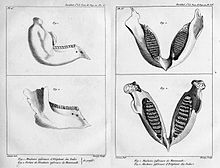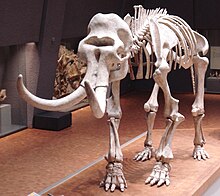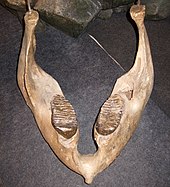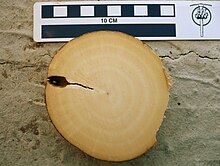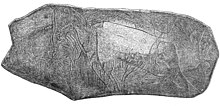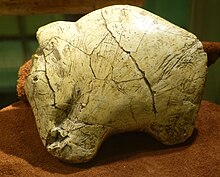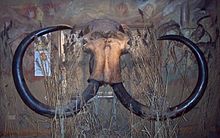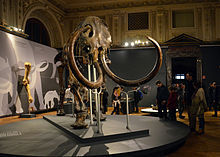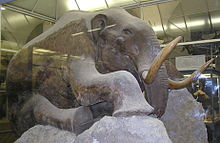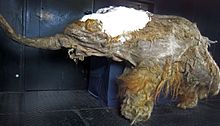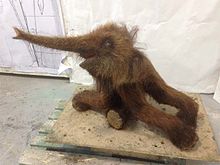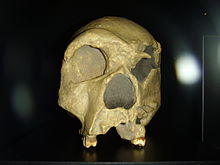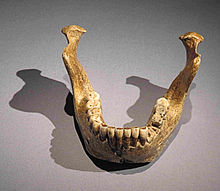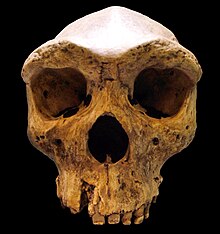| Woolly mammoth | |
|---|---|

| |
| Largest European specimen, a male at Südostbayerisches Naturkunde- und Mammut-Museum Siegsdorf | |
| Scientific classification | |
| Kingdom: | Animalia |
| Phylum: | Chordata |
| Clade: | Tetrapodomorpha |
| Class: | Mammalia |
| Order: | Proboscidea |
| Family: | Elephantidae |
| Genus: | †Mammuthus |
| Species: | †M. primigenius |
| Binomial name | |
| Mammuthus primigenius
(Blumenbach, 1799)
| |

| |
| Dymaxion map showing the Late Pleistocene distribution of M. primigenius in blue (light blue was land at the time), inferred from fossil finds | |
The woolly mammoth (Mammuthus primigenius) is an extinct species of mammoth that lived during the Pleistocene until its extinction in the early Holocene epoch. It was one of the last in a line of mammoth species, beginning with Mammuthus subplanifrons in the early Pliocene. The woolly mammoth diverged from the steppe mammoth about 400,000 years ago in East Asia. Its closest extant relative is the Asian elephant. The appearance and behaviour of this species are among the best studied of any prehistoric animal because of the discovery of frozen carcasses in Siberia and Alaska, as well as skeletons, teeth, stomach contents, dung, and depiction from life in prehistoric cave paintings. Mammoth remains had long been known in Asia before they became known to Europeans in the 17th century. The origin of these remains was long a matter of debate, and often explained as being remains of legendary creatures. The mammoth was identified as an extinct species of elephant by Georges Cuvier in 1796.
The woolly mammoth was roughly the same size as modern African elephants. Males reached shoulder heights between 2.7 and 3.4 m (8.9 and 11.2 ft) and weighed up to 6 metric tons (6.6 short tons). Females reached 2.6–2.9 m (8.5–9.5 ft) in shoulder heights and weighed up to 4 metric tons (4.4 short tons). A newborn calf weighed about 90 kilograms (200 lb). The woolly mammoth was well adapted to the cold environment during the last ice age. It was covered in fur, with an outer covering of long guard hairs and a shorter undercoat. The colour of the coat varied from dark to light. The ears and tail were short to minimise frostbite and heat loss. It had long, curved tusks and four molars, which were replaced six times during the lifetime of an individual. Its behaviour was similar to that of modern elephants, and it used its tusks and trunk for manipulating objects, fighting, and foraging. The diet of the woolly mammoth was mainly grass and sedges. Individuals could probably reach the age of 60. Its habitat was the mammoth steppe, which stretched across northern Eurasia and North America.
The woolly mammoth coexisted with early humans, who used its bones and tusks for making art, tools, and dwellings, and the species was also hunted for food. It disappeared from its mainland range at the end of the Pleistocene 10,000 years ago, most likely through climate change and consequent shrinkage of its habitat, hunting by humans, or a combination of the two. Isolated populations survived on St. Paul Island until 5,600 years ago and on Wrangel Island until 4,000 years ago. After its extinction, humans continued using its ivory as a raw material, a tradition that continues today. It has been proposed the species could be recreated through various means, but none of these are yet feasible.
Taxonomy
Copy of an interpretation of the "Adams mammoth" carcass from around 1800, with Johann Friedrich Blumenbach's handwriting
Remains of various extinct elephants were known by Europeans for centuries, but were generally interpreted, based on biblical accounts, as the remains of legendary creatures such as behemoths or giants. It was also theorised that they were remains of modern elephants that had been brought to Europe during the Roman Republic, for example the war elephants of Hannibal and Pyrrhus of Epirus, or animals that had wandered north. The first woolly mammoth remains studied by European scientists were examined by Hans Sloane in 1728 and consisted of fossilised teeth and tusks from Siberia. Sloane was the first to recognise that the remains belonged to elephants. Sloane turned to another biblical explanation for the presence of elephants in the Arctic, asserting that they had been buried during the Great Flood, and that Siberia had previously been tropical before a drastic climate change. Others interpreted Sloane's conclusion slightly differently, arguing the flood had carried elephants from the Tropics to the Arctic. Sloane's paper was based on travellers' descriptions and a few scattered bones collected in Siberia and Britain. He discussed the question of whether or not the remains were from elephants, but drew no conclusions. In 1738, the German zoologist Johann Philipp Breyne argued that mammoth fossils represented some kind of elephant. He could not explain why a tropical animal would be found in such a cold area as Siberia, and suggested that they might have been transported there by the Great Flood. In 1796, the French anatomist Georges Cuvier was the first to identify the woolly mammoth remains not as modern elephants transported to the Arctic, but as an entirely new species. He argued this species had gone extinct and no longer existed, a concept that was not widely accepted at the time.
Following Cuvier's identification, the German naturalist Johann Friedrich Blumenbach gave the woolly mammoth its scientific name, Elephas primigenius, in 1799, placing it in the same genus as the Asian elephant. This name is Latin for "first elephant". Cuvier coined the name Elephas mammonteus a few months later, but the former name was subsequently used. In 1828, the British naturalist Joshua Brookes used the name Mammuthus borealis for woolly mammoth fossils in his collection that he put up for sale, thereby coining a new genus name. It is unclear where and how the word "mammoth" originated. According to the Oxford English Dictionary, it comes from an old Vogul word mēmoŋt, "earth-horn". It may be a version of mehemot, the Arabic version of the biblical word "behemoth". Another possible origin is Estonian, where maa means "earth", and mutt means "mole". The word was first used in Europe during the early 17th century, when referring to maimanto tusks discovered in Siberia. The American president Thomas Jefferson, who had a keen interest in palaeontology, was partially responsible for transforming the word mammoth from a noun describing the prehistoric elephant to an adjective describing anything of surprisingly large size. The first recorded use of the word as an adjective was in a description of a wheel of cheese (the "Cheshire Mammoth Cheese") given to Jefferson in 1802.
1930s illustration of the lectotype molars by Henry Fairfield Osborn. The left one is now lost.
By the early 20th century the taxonomy of extinct elephants was complex. In 1942, the American palaoentologist Henry Fairfield Osborn's posthumous monograph on the Proboscidea was published, wherein he used various taxon names that had previously been proposed for mammoth species, including replacing Mammuthus with Mammonteus, as he believed the former name to be invalidly published. Mammoth taxonomy was simplified by various researchers from the 1970s onwards, all species were retained in the genus Mammuthus, and many proposed differences between species were instead interpreted as intraspecific variation. Osborn chose two molars (found in Siberia and Osterode) from Blumenbach's collection at Göttingen University as the lectotype specimens for the woolly mammoth, since holotype designation was not practised in Blumenbach's time. The Russian palaeontologist Vera Gromova further proposed the former should be considered the lectotype with the latter as paralectotype. Both molars were thought lost by the 1980s, and the more complete "Taimyr mammoth" found in Siberia in 1948 was therefore proposed as the neotype specimen in 1990. Resolutions to historical issues about the validity of the genus name Mammuthus and the type species designation of E. primigenius were also proposed. The paralectotype molar (specimen GZG.V.010.018) has since been located in the Göttingen University collection, identified by comparing it with Osborn's illustration of a cast.
Evolution
The earliest known members of Proboscidea, the clade which contains modern elephants, existed about 55 million years ago around the Tethys Sea. The closest known relatives of the Proboscidea are the sirenians (dugongs and manatees) and the hyraxes (an order of small, herbivorous mammals). The family Elephantidae existed six million years ago in Africa and includes the modern elephants and the mammoths. Among many now extinct clades, the mastodon (Mammut) is only a distant relative of the mammoths, and part of the separate family Mammutidae, which diverged 25 million years before the mammoths evolved. The following cladogram shows the placement of the genus Mammuthus among other proboscideans, based on characteristics of the hyoid bone in the neck:
Georges Cuvier's 1796 comparison between the mandible of a woolly mammoth (bottom left and top right) and an Indian elephant (top left and bottom right)
Comparison between a woolly mammoth (left) and an American mastodon (right)
In 2005, researchers assembled a complete mitochondrial genome profile of the woolly mammoth, which allowed them to trace the close evolutionary relationship between mammoths and Asian elephants (Elephas maximus). A 2015 DNA review confirmed Asian elephants as the closest living relative of the woolly mammoth. African elephants (Loxodonta africana) branched away from this clade around 6 million years ago, close to the time of the similar split between chimpanzees and humans. Before the publication of the Neanderthal genome, many researchers expected the first fully sequenced nuclear genome of an extinct species would be that of the mammoth. A 2010 study confirmed these relationships, and suggested the mammoth and Asian elephant lineages diverged 5.8–7.8 million years ago, while African elephants diverged from an earlier common ancestor 6.6–8.8 million years ago. In 2008, much of the woolly mammoth's chromosomal DNA was mapped. The analysis showed that the woolly mammoth and the African elephant are 98.55% to 99.40% identical. The team mapped the woolly mammoth's nuclear genome sequence by extracting DNA from the hair follicles of both a 20,000-year-old mammoth retrieved from permafrost, and another that died 60,000 years ago. In 2012, proteins were confidently identified for the first time, collected from a 43,000-year-old woolly mammoth.
Since many remains of each species of mammoth are known from several localities, it is possible to reconstruct the evolutionary history of the genus through morphological studies. Mammoth species can be identified from the number of enamel ridges (or lamellar plates) on their molars; primitive species had few ridges, and the number increased gradually as new species evolved to feed on more abrasive food items. The crowns of the teeth became deeper in height and the skulls became taller to accommodate this. At the same time, the skulls became shorter from front to back to minimise the weight of the head. The short and tall skulls of woolly and Columbian mammoths (Mammuthus columbi) are the culmination of this process.
Cast of an intermediate form between M. trogontherii and M. primigenius; M. p. fraasi, Staatliches Museum für Naturkunde Stuttgart
The first known members of the genus Mammuthus are the African species Mammuthus subplanifrons from the Pliocene, and M. africanavus from the Pleistocene. The former is thought to be the ancestor of later forms. Mammoths entered Europe around 3 million years ago. The earliest European mammoth has been named M. rumanus; it spread across Europe and China. Only its molars are known, which show that it had 8–10 enamel ridges. A population evolved 12–14 ridges, splitting off from and replacing the earlier type, becoming M. meridionalis about 2–1.7 million years ago. In turn, this species was replaced by the steppe mammoth (M. trogontherii) with 18–20 ridges, which evolved in eastern Asia around 1 million years ago. The Columbian mammoth evolved from a population of M. trogontherii that had crossed the Bering Strait and entered North America about 1.5 million years ago; it retained a similar number of molar ridges. Mammoths derived from M. trogontherii evolved molars with 26 ridges 400,000 years ago in Siberia and became the woolly mammoth. Woolly mammoths entered North America about 100,000 years ago. Asian elephants have a variable number of enamel ridges that is intermediate between those of the Columbian/steppe mammoth and the woolly mammoth.
Individuals and populations showing transitional morphologies between each of the mammoth species are known, and primitive and derived species coexisted as well until the former disappeared. The different species and their intermediate forms have therefore been termed "chronospecies". Many taxa intermediate between M. primigenius and other mammoths have also been proposed, but their validity is uncertain; depending on author, they are either considered primitive forms of an advanced species or advanced forms of a primitive species. Distinguishing and determining these intermediate forms has been called one of the most long lasting and complicated problems in Quaternary palaeontology. Regional and intermediate species and subspecies such as M. intermedius, M. chosaricus, M. p. primigenius, M. p. jatzkovi, M. p. sibiricus, M. p. fraasi, M. p. leith-adamsi, M. p. hydruntinus, M. p. astensis, M. p. americanus, M. p. compressus, and M. p. alaskensis have been proposed.
A 2011 genetic study showed that two examined specimens of the Columbian mammoth were grouped within a subclade of woolly mammoths. This suggests that the two populations interbred and produced fertile offspring. A North American type formerly referred to as M. jeffersonii may be a hybrid between the two species. A 2015 study suggested that the animals in the range where M. columbi and M. primigenius overlapped formed a metapopulation of hybrids with varying morphology. It also suggested that Eurasian M. primigenius had a similar relationship with M. trogontherii, in areas where their range overlapped.
Description
Size (red) compared to a human and other mammoths
The appearance of the woolly mammoth is probably the best known of any prehistoric animal due to the many frozen specimens with preserved soft tissue and depictions by contemporary humans in their art. Fully grown males reached shoulder heights between 2.7 and 3.4 m (8.9 and 11.2 ft) and weighed up to 6 tonnes (6.6 short tons). This is almost as large as extant male African elephants, which commonly reach a shoulder height of 3–3.4 m (9.8–11.2 ft), and is less than the size of the earlier mammoth species M. meridionalis and M. trogontherii, and the contemporary M. columbi. The reason for the smaller size is unknown. Female woolly mammoths reached 2.6–2.9 m (8.5–9.5 ft) in shoulder heights and were built more lightly than males, weighing up to 4 tonnes (4.4 short tons). A newborn calf would have weighed about 90 kg (200 lb). These sizes are deduced from comparison with modern elephants of similar size. Few frozen specimens have preserved genitals, so the gender is usually determined through examination of the skeleton. The best indication of sex is the size of the pelvic girdle, since the opening that functions as the birth canal is always wider in females than in males. Though the mammoths on Wrangel Island were smaller than those of the mainland, their size varied, and they were not small enough to be considered "dwarves". It has been claimed that the last woolly mammoth populations decreased in size and increased their sexual dimorphism, but this was dismissed in a 2012 study.
Cave art depicting a woolly mammoth and other animals, from the Rouffignac Cave, France
Woolly mammoths had several adaptations to the cold, most noticeably the layer of fur covering all parts of the body. Other adaptations to cold weather include ears that are far smaller than those of modern elephants; they were about 38 cm (15 in) long and 18–28 cm (7.1–11.0 in) across, and the ear of the 6–12 month old frozen calf "Dima" was under 13 cm (5.1 in) long. The small ears reduced heat loss and frostbite, and the tail was short for the same reason, only 36 cm (14 in) long in the "Berezovka mammoth". The tail contained 21 vertebrae, whereas the tails of modern elephants contain 28–33. Their skin was no thicker than that of present-day elephants, between 1.25 and 2.5 cm (0.49 and 0.98 in). They had a layer of fat up to 10 cm (3.9 in) thick under the skin, which helped to keep them warm. Woolly mammoths had broad flaps of skin under their tails which covered the anus; this is also seen in modern elephants.
Model at the Royal BC Museum
Other characteristic features depicted in cave paintings include a large, high, single-domed head and a sloping back with a high shoulder hump; this shape resulted from the spinous processes of the back vertebrae decreasing in length from front to rear. These features were not present in juveniles, which had convex backs like Asian elephants. Another feature shown in cave paintings was confirmed by the discovery of a frozen specimen in 1924, an adult nicknamed the "Middle Kolyma mammoth", which was preserved with a complete trunk tip. Unlike the trunk lobes of modern elephants, the upper "finger" at the tip of the trunk had a long pointed lobe and was 10 cm (3.9 in) long, while the lower "thumb" was 5 cm (2.0 in) and was broader. The trunk of "Dima" was 76 cm (2.49 ft) long, whereas the trunk of the adult "Liakhov mammoth" was 2 metres (6.6 ft) long. The well-preserved trunk of a juvenile specimen nicknamed "Yuka" was described in 2015, and it was shown that it possessed a fleshy expansion a third above the tip. Rather than oval as the rest of the trunk, this part was ellipsoidal in cross section, and double the size in diameter. The feature was also shown to be present in two other specimens, of different sexes and ages.
Coat
The coat consisted of an outer layer of long, coarse "guard hair", which was 30 cm (12 in) on the upper part of the body, up to 90 cm (35 in) in length on the flanks and underside, and 0.5 mm (0.020 in) in diameter, and a denser inner layer of shorter, slightly curly under-wool, up to 8 cm (3.1 in) long and 0.05 mm (0.0020 in) in diameter. The hairs on the upper leg were up to 38 cm (15 in) long, and those of the feet were 15 cm (5.9 in) long, reaching the toes. The hairs on the head were relatively short, but longer on the underside and the sides of the trunk. The tail was extended by coarse hairs up to 60 cm (24 in) long, which were thicker than the guard hairs. It is likely that the woolly mammoth moulted seasonally, and that the heaviest fur was shed during spring. Since mammoth carcasses were more likely to be preserved during autumn, it is possible that only the winter coat has been preserved in frozen specimens. Modern elephants have much less hair, though juveniles have a more extensive covering of hair than adults. Comparison between the over-hairs of woolly mammoths and extant elephants show that they did not differ much in overall morphology. Woolly mammoths had numerous sebaceous glands in their skin, which secreted oils into their hair; this would have improved the wool's insulation, repelled water, and given the fur a glossy sheen.
Preserved woolly mammoth fur is orange-brown, but this is believed to be an artefact from the bleaching of pigment during burial. The amount of pigmentation varied from hair to hair and also within each hair. A 2006 study sequenced the Mc1r gene (which influences hair colour in mammals) from woolly mammoth bones. Two alleles were found: a dominant (fully active) and a recessive (partially active) one. In mammals, recessive Mc1r alleles result in light hair. Mammoths born with at least one copy of the dominant allele would have had dark coats, while those with two copies of the recessive allele would have had light coats. A 2011 study showed that light individuals would have been rare. A 2014 study instead indicated that the colouration of an individual varied from non-pigmented on the overhairs, bi-coloured, non-pigmented and mixed red-brown guard hairs, and non-pigmented underhairs, which would give a light overall appearance.
Dentition
Skeleton with asymmetrical tusks, Barcelona Mammoth Museum
Woolly mammoths had very long tusks (modified incisor teeth), which were more curved than those of modern elephants. The largest known male tusk is 4.2 m (14 ft) long and weighs 91 kg (201 lb), but 2.4–2.7 m (7.9–8.9 ft) and 45 kg (99 lb) was a more typical size. Female tusks were smaller and thinner, averaging at 1.5–1.8 m (4.9–5.9 ft) and weighing 9 kg (20 lb). The sheaths of the tusks were parallel and spaced closely. About a quarter of the length was inside the sockets. The tusks grew spirally in opposite directions from the base and continued in a curve until the tips pointed towards each other, sometimes crossing. In this way, most of the weight would have been close to the skull, and there would be less torque than with straight tusks. The tusks were usually asymmetrical and showed considerable variation, with some tusks curving down instead of outwards and some being shorter due to breakage. Calves developed small milk tusks a few centimetres long at six months old, which were replaced by permanent tusks a year later. Tusk growth continued throughout life but became slower as the animal reached adulthood. The tusks grew by 2.5–15 cm (0.98–5.91 in) each year. Some cave paintings show woolly mammoths with small or no tusks, but it is unknown whether this reflected reality or was artistic license. Female Asian elephants have no tusks, but there is no fossil evidence that any adult woolly mammoths lacked them.
Molar from Font de Champdamoy, France, Musée Georges-Garret
Woolly mammoths had four functional molar teeth at a time, two in the upper jaw and two in the lower. About 23 cm (9.1 in) of the crown was within the jaw, and 2.5 cm (1 in) was above. The crown was continually pushed forwards and up as it wore down, comparable to a conveyor belt. The teeth had up to 26 separated ridges of enamel, which were themselves covered in "prisms" that were directed towards the chewing surface. These were quite wear resistant and kept together by cementum and dentine. A mammoth had six sets of molars throughout a lifetime, which were replaced five times, though a few specimens with a seventh set are known. The latter condition could extend the lifespan of the individual, unless the tooth consisted of only a few plates. The first molars were about the size of those of a human, 1.3 cm (0.51 in), the third were 15 cm (6 in) 15 cm (5.9 in) long, and the sixth were about 30 cm (1 ft) long and weighed 1.8 kg (4 lb). The molars grew larger and contained more ridges with each replacement. The woolly mammoth is considered to have had the most complex molars of any elephant.
Distortion in the molars is the most common health problem found in woolly mammoth fossils. Sometimes the replacement was disrupted, and the molars were pushed into abnormal positions, but some animals are known to have survived this. Teeth from Britain showed that 2% of specimens had periodontal disease, with half of these containing caries. The teeth also sometimes had cancerous growths.
Palaeobiology
Artwork of fauna during the Pleistocene epoch in northern Spain, by Mauricio Antón, 2004
Adult woolly mammoths could effectively defend themselves from predators with their tusks, trunks and size, but juveniles and weakened adults were vulnerable to pack hunters such as wolves, cave hyenas and large felines. The tusks may also have been used in intra-species fighting, such as territorial fights or fights over mates. Display of the large tusks of males could also have been used to attract females, and to intimidate rivals. Because of their curvature, the tusks were not suitable for stabbing, but may have been used for hitting, as indicated by injuries to some fossil shoulder blades. The very long hairs on the tail probably compensated for the shortness of the tail, enabling its use as a flyswatter, similar to the tail on modern elephants. As in modern elephants, the sensitive and muscular trunk worked as a limb-like organ with many functions. It was used for manipulating objects, and in social interactions. The well-preserved foot of the adult male "Yukagir mammoth" shows that the soles of the feet contained many cracks that would have helped in gripping surfaces during locomotion. Like modern elephants, woolly mammoths walked on their toes and had large, fleshy pads behind the toes.
Mounted "family group" from Russia
Like modern elephants, woolly mammoths were likely very social and lived in matriarchal (female-led) family groups. This is supported by fossil assemblages and cave paintings showing groups. It is therefore probable that most of their other social behaviour was similar to that of modern elephants. It is unknown how many mammoths lived at one location at a time, as fossil deposits are often accumulations of individuals that died over long periods of time. It is likely that the amounts varied by season and life-cycle events. Modern elephants can form large herds, sometimes consisting of multiple family groups, and these herds can include thousands of animals migrating together. Mammoths may have formed large herds more often, since animals that live in open areas are more likely to do this than those in forested areas. Trackways made by a woolly mammoth herd 11,300–11,000 years ago have been found in the St. Mary Reservoir in Canada, showing that there were in this case almost equal numbers of adults, sub-adults and juveniles. The adults had a stride of 2 m (6.6 ft), and the juveniles ran to keep up.
Limb with skin and hair, National Museum of Natural History, Paris
The woolly mammoth was probably the most specialised member of the family Elephantidae. They had lipopexia (fat storage) in their neck and withers, for times when food availability was insufficient during winter, and their first three molars grew more quickly than in the calves of modern elephants. The expansion identified on the trunk of "Yuka" and other specimens was suggested to function as a "fur mitten"; the trunk tip was not covered in fur, but was used for foraging during winter, and could have been heated by curling it into the expansion. It was also suggested that the expansion could be used to melt snow if there was shortage of water to drink, as melting it directly inside the mouth could disturb the thermal balance of the animal. As in reindeer and musk oxen, the haemoglobin of the woolly mammoth was adapted to the cold, with three mutations to improve oxygen delivery around the body and prevent freezing. This feature may have helped the mammoths to live in high latitudes.
In a 2015 study, high-quality genome sequences from three Asian elephants and two woolly mammoths were compared. Approximately 1.4 million DNA nucleotide differences were found between mammoths and elephants, which affect the sequence of more than 1,600 proteins. Differences were noted in genes for a number of aspects of physiology and biology that would be relevant to Arctic survival, including development of skin and hair, storage and metabolism of adipose tissue, and perceiving temperature. Genes related to both sensing temperature and transmitting that sensation to the brain were altered. One of the heat-sensing genes encodes a protein, TRPV3, found in skin which also affects hair growth. When inserted into human cells, the mammoth's version of the protein was found to be less sensitive to heat than the elephant's. This is consistent with a previous observation that mice lacking active TRPV3 are likely to spend more time in cooler cage locations than wild type mice, and have wavier hair. There were also several alterations in circadian clock genes, perhaps needed to cope with the extreme polar variation in length of daylight. Similar mutations are known in other Arctic mammals, such as reindeer.
Diet
The frozen calf "Lyuba" which still had food in its stomach, Royal BC Museum
Food at various stages of digestion has been found in the intestines of several woolly mammoths, giving a good picture of their diet. Woolly mammoths sustained themselves on plant food, mainly grass and sedges, which were supplemented with herbaceous plants, flowering plants, shrubs, mosses, and tree matter. The composition and exact varieties differed from location to location. Woolly mammoths needed a varied diet to support their growth, like modern elephants. An adult of six tons would need to eat 180 kg (397 lb) daily, and may have foraged as long as twenty hours every day. The two-fingered tip of the trunk was probably adapted for picking up the short grasses of the last ice age (Quaternary glaciation, 2.58 million years ago to present) by wrapping around them, whereas modern elephants curl their trunks around the longer grass of their tropical environments. The trunk could also be used for pulling off large grass tufts, delicately picking buds and flowers, and tearing off leaves and branches where trees and shrubs were present. The "Yukagir mammoth" had ingested plant matter that contained spores of dung fungus. Isotope analysis shows that woolly mammoths fed mainly on C3 plants, unlike horses and rhinos.
Mandibles and lower molars, Barcelona
Scientists identified milk in the stomach and faecal matter in the intestines of the mammoth calf "Lyuba". The faecal matter may have been eaten by "Lyuba" to promote development of the intestinal microbes necessary for digestion of vegetation, as is the case in modern elephants. An isotope analysis of woolly mammoths from Yukon showed that the young nursed for at least three years, and were weaned and gradually changed to a diet of plants when they were two to three years old. This is later than in modern elephants and may be due to a higher risk of predator attack or difficulty in obtaining food during the long periods of winter darkness in high latitudes.
The molars were adapted to their diet of coarse tundra grasses, with more enamel plates and a higher crown than their earlier, southern relatives. The woolly mammoth chewed its food by using its powerful jaw muscles to move the mandible forwards and close the mouth, then backwards while opening; the sharp enamel ridges thereby cut across each other, grinding the food. The ridges were wear-resistant to enable the animal to chew large quantities of food, which often contained grit. Woolly mammoths may have used their tusks as shovels to clear snow from the ground and reach the vegetation buried below, and to break ice to drink. This is indicated on many preserved tusks by flat, polished sections up to 30 centimetres (12 in) long on the part of the surface that would have reached the ground. The tusks were also used for obtaining food in other ways, such as digging up plants and stripping off bark.
Life history
Cross sectioned tusk with growth rings
The lifespan of mammals is related to their size, and since modern elephants can reach the age of 60 years, the same is thought to be true for woolly mammoths which were of a similar size. The age of a mammoth can be roughly determined by counting the growth rings of its tusks when viewed in cross section, but this does not account for their early years, as these are represented by the tips of the tusks, which are usually worn away. In the remaining part of the tusk, each major line represents a year, and weekly and daily ones can be found in between. Dark bands correspond to summers, and it is therefore possible to determine the season in which a mammoth died. The growth of the tusks slowed when it became harder to forage, for example during winter, during disease, or when a male was banished from the herd (male elephants live with their herds until about the age of ten). Mammoth tusks dating to the harshest period of the last glaciation 25–20,000 years ago show slower growth rates. Woolly mammoths continued growing past adulthood, like other elephants. Unfused limb bones show that males grew until they reached the age of 40, and females grew until they were 25. The frozen calf "Dima" was 90 cm (35 in) tall when it died at the age of 6–12 months. At this age, the second set of molars would be in the process of erupting, and the first set would be worn out at 18 months of age. The third set of molars lasted for ten years, and this process was repeated until the final, sixth set emerged when the animal was 30 years old. When the last set of molars was worn out, the animal would be unable to chew and feed, and it would die of starvation. A study of North American mammoths found that they often died during winter or spring, the hardest times for northern animals to survive.
Head of the "Yukagir mammoth"; the trunk is not preserved
The best-preserved head of a frozen adult specimen, that of a male nicknamed the "Yukagir mammoth", shows that woolly mammoths had temporal glands between the ear and the eye. This feature indicates that, like bull elephants, male woolly mammoths also entered "musth", a period of heightened aggressiveness. The glands are used especially by males to produce an oily substance with a strong smell called temporin. Their fur may have helped in spreading the scent further.
Examination of preserved calves show that they were all born during spring and summer, and since modern elephants have gestation periods of 21–22 months, it is probable that the mating season was from summer to autumn. δ15N isotopic analysis of the teeth of "Lyuba" has demonstrated their prenatal development, and indicates its gestation period was similar to that of a modern elephant, and that it was born in spring.
Evidence of several different bone diseases has been found in woolly mammoths. The most common of these diseases was osteoarthritis, found in 2% of specimens. One specimen from Switzerland had several fused vertebrae as a result of this condition. The "Yukagir mammoth" had suffered from spondylitis in two vertebrae, and osteomyelitis is also known from some specimens. Several specimens have healed bone fractures, showing that the animals had survived these injuries. An abnormal number of cervical vertebrae has been found in 33% of specimens from the North Sea region, probably due to inbreeding in a declining population. Parasitic flies and protozoa were identified in the gut of the calf "Dima".
Distribution and habitat
Map
showing climatic suitability for woolly mammoths in the Late
Pleistocene and Holocene of Eurasia: red is increasing suitability,
green is decreasing suitability. Black points are records of mammoths,
black lines are the northern limit of humans
The habitat of the woolly mammoth is known as "mammoth steppe" or "tundra steppe". This environment stretched across northern Asia, many parts of Europe, and the northern part of North America during the last ice age. It was similar to the grassy steppes of modern Russia, but the flora was more diverse, abundant, and grew faster. Grasses, sedges, shrubs, and herbaceous plants were present, and scattered trees were mainly found in southern regions. This habitat was not dominated by ice and snow, as is popularly believed, since these regions are thought to have been high-pressure areas at the time. The habitat of the woolly mammoth also supported other grazing herbivores such as the woolly rhinoceros, wild horses and bison. A 2014 study concluded that forbs (a group of herbaceous plants) were more important in the steppe-tundra than previously acknowledged, and that it was a primary food source for the ice-age megafauna.
Mural depicting a herd walking near the Somme River in France, by Charles R. Knight, 1916, American Museum of Natural History
The southernmost woolly mammoth specimen known is from the Shandong province of China, and is 33,000 years old. The southernmost European remains are from the Depression of Granada in Spain and are of roughly the same age. DNA studies have helped determine the phylogeography of the woolly mammoth. A 2008 DNA study showed there were two distinct groups of woolly mammoths: one that became extinct 45,000 years ago and another one that became extinct 12,000 years ago. The two groups are speculated to be divergent enough to be characterised as subspecies. The group that became extinct earlier stayed in the middle of the high Arctic, while the group with the later extinction had a much wider range. Recent stable isotope studies of Siberian and New World mammoths have shown there were also differences in climatic conditions on either side of the Bering land bridge, with Siberia being more uniformly cold and dry throughout the Late Pleistocene. During the Younger Dryas age, woolly mammoths briefly expanded into north-east Europe, whereafter the mainland populations became extinct.
A 2008 genetic study showed that some of the woolly mammoths that entered North America through the Bering land bridge from Asia migrated back about 300,000 years ago and had replaced the previous Asian population by about 40,000 years ago, not long before the entire species became extinct. Fossils of woolly mammoths and Columbian mammoths have been found together in a few localities of North America, including the Hot Springs sinkhole of South Dakota where their regions overlapped. It is unknown whether the two species were sympatric and lived there simultaneously, or if the woolly mammoths may have entered these southern areas during times when Columbian mammoth populations were absent there.
Relationship with humans
Woolly mammoth engraved on ivory, discovered by Édouard Lartet in 1864
Modern humans coexisted with woolly mammoths during the Upper Palaeolithic period when the humans entered Europe from Africa between 30,000 and 40,000 years ago. Before this, Neanderthals had coexisted with mammoths during the Middle Palaeolithic, and already utilised mammoth bones for tool making and building materials. Woolly mammoths were very important to ice-age humans, and human survival may have depended on the mammoth in some areas. Evidence for such coexistence was not recognised until the 19th century. William Buckland published his discovery of the Red Lady of Paviland skeleton in 1823, which was found in a cave alongside woolly mammoth bones, but he mistakenly denied that these were contemporaries. In 1864, Édouard Lartet found an engraving of a woolly mammoth on a piece of mammoth ivory in the Abri de la Madeleine cave in Dordogne, France. The engraving was the first widely accepted evidence for the coexistence of humans with prehistoric extinct animals and is the first contemporary depiction of such a creature known to modern science.
Replica of a ca. 26,000-year-old ivory carving depicting a mammoth, Krahuletz-Museum
The woolly mammoth is the third most depicted animal in ice-age art, after horses and bison, and these images were produced between 35,000 and 11,500 years ago. Today, more than five hundred depictions of woolly mammoths are known, in media ranging from cave paintings and engravings on the walls of 46 caves in Russia, France and Spain to engravings and sculptures (termed "portable art") made from ivory, antler, stone and bone. Cave paintings of woolly mammoths exist in several styles and sizes. The French Rouffignac Cave has the most depictions, 159, and some of the drawings are more than 2 metres (6.6 ft) in length. Other notable caves with mammoth depictions are the Chauvet Cave, Les Combarelles Cave, and Font-de-Gaume. A depiction in the Cave of El Castillo may instead show Palaeoloxodon, the "straight-tusked elephant".
"Portable art" can be more accurately dated than cave art since it is found in the same deposits as tools and other ice age artefacts. The largest collection of portable mammoth art, consisting of 62 depictions on 47 plaques, was found in the 1960s at an excavated open-air camp near Gönnersdorf in Germany. There does not seem to be a correlation between the number of mammoths depicted and the species that were most often hunted, since reindeer bones are the most frequently found animal remains at the site. Two spear throwers shaped as woolly mammoths have also been found in France. Some portable mammoth depictions may not have been produced where they were discovered, but could have moved around by ancient trading.
Exploitation
Reconstructed bone hut based on finds in Mezhyrich, exhibited in Japan
Woolly mammoth bones were used as construction material for dwellings by both Neanderthals and modern humans during the ice age. More than 70 such dwellings are known, mainly from the Russian Plain. The bases of the huts were circular, and ranged from 8 to 24 square metres (86 to 258 sq ft). The arrangement of dwellings varied, and ranged from 1 m (3.3 ft) to 20 m (66 ft) apart, depending on location. Large bones were used as foundations for the huts, tusks for the entrances, and the roofs were probably skins held in place by bones or tusks. Some huts had floors that extended 40 cm (16 in) below ground. Some huts included fireplaces, which used bones as fuel, probably because wood was scarce. It is possible that some of the bones used for materials came from mammoths killed by humans, but the state of the bones, and the fact that bones used to build a single dwelling varied by several thousands of years in age, suggests that they were collected remains of long-dead animals. Woolly mammoth bones were also made into various tools, furniture, and musical instruments. Large bones, such as shoulder blades, were also used to cover dead human bodies during burial.
The Venus of Brassempouy, made from woolly mammoth ivory, National Archaeological Museum, France
Woolly mammoth ivory was used to create art objects. Several Venus figurines, including the Venus of Brassempouy and the Venus of Lespugue, were made from this material. Weapons made from ivory, such as daggers, spears, and a boomerang, are also known. To be able to process the ivory, the large tusks had to be chopped, chiselled and split into smaller, more manageable pieces. Some ivory artefacts show that tusks had been straightened, and it is unknown how this was achieved.
Several woolly mammoth specimens show evidence of being butchered by humans, which is indicated by breaks, cut-marks, and associated stone tools. It is not known how much prehistoric humans relied on woolly mammoth meat, since there were many other large herbivores available. Many mammoth carcasses may have been scavenged by humans rather than hunted. Some cave paintings show woolly mammoths in structures interpreted as pitfall traps. Few specimens show direct, unambiguous evidence of having been hunted by humans. A Siberian specimen with a spearhead embedded in its shoulder blade shows that a spear had been thrown at it with great force. A specimen from the Mousterian age of Italy shows evidence of spear hunting by Neanderthals. The juvenile specimen nicknamed "Yuka" is the first frozen mammoth with evidence of human interaction. It shows evidence of having been killed by a large predator, and of having been scavenged by humans shortly after. Some of its bones had been removed, and were found nearby. A site near the Yana River in Siberia has revealed several specimens with evidence of human hunting, but the finds were interpreted to show that the animals were not hunted intensively, but perhaps mainly when ivory was needed. Two woolly mammoths from Wisconsin, the "Schaefer" and "Hebior mammoths", show evidence of having been butchered by Palaeoamericans.
Extinction
16,500-year-old mammoth spear thrower from France, British Museum
Most woolly mammoth populations disappeared during the late Pleistocene and early Holocene, alongside most of the Pleistocene megafauna (including the Columbian mammoth). This extinction formed part of the Quaternary extinction event, which began 40,000 years ago and peaked between 14,000 and 11,500 years ago. Scientists are divided over whether hunting or climate change, which led to the shrinkage of its habitat, was the main factor that contributed to the extinction of the woolly mammoth, or whether it was due to a combination of the two. Whatever the cause, large mammals are generally more vulnerable than smaller ones due to their smaller population size and low reproduction rates. Different woolly mammoth populations did not die out simultaneously across their range, but gradually became extinct over time. Most populations disappeared between 14,000 and 10,000 years ago. The last mainland population existed in the Kyttyk Peninsula of Siberia 9,650 years ago. A small population of woolly mammoths survived on St. Paul Island, Alaska, well into the Holocene with the most recently published date of extinction being 5,600 years B.P. The last known population remained on Wrangel Island in the Arctic Ocean until 4,000 years ago, well into the start of human civilization and concurrent with the construction of the Great Pyramid of ancient Egypt.
DNA sequencing of remains of two mammoths, one from Siberia 44,800 years BP and one from Wrangel Island 4,300 years BP, indicates two major population crashes: one around 280,000 years ago from which the population recovered, and a second about 12,000 years ago, near the ice age's end, from which it did not. The Wrangel Island mammoths were isolated for 5000 years, and due to the small population present when the island was isolated by rising post-ice-age sea level, about 300 to 1000 individuals experienced a 20% to 30% loss of heterozygosity, and a 65% loss in mitochondrial DNA diversity. The population seems to have subsequently been stable, without suffering further significant loss of genetic diversity. Genetic evidence thus implies the extinction of this final population was sudden, rather than the culmination of a gradual decline.
Skull and jaw of the calf "Yuka", which may have been extracted from the carcass by prehistoric humans
Before their extinction, the Wrangel Island mammoths had accumulated numerous genetic defects due to their small population, consistent with the concept of genomic meltdown; in particular, a number of genes for olfactory receptors and urinary proteins became nonfunctional, possibly because they had lost their selective value on the island environment. It is not clear whether these genetic changes contributed to their extinction. The disappearance coincides roughly in time with the first evidence for humans on the island. The woolly mammoths of eastern Beringia (modern Alaska and Yukon) had similarly died out about 13,300 years ago, soon (roughly 1000 years) after the first appearance of humans in the area, which parallels the fate of all the other late Pleistocene proboscids (mammoths, gomphotheres and mastodons), as well as most of the rest of the megafauna, of the Americas. In contrast, the St. Paul Island mammoth population apparently died out before human arrival because of habitat shrinkage resulting from the post-ice-age sea-level rise, perhaps in large measure as a result of a consequent reduction in the freshwater supply.
Changes in climate shrank suitable mammoth habitat from 7,700,000 km2 (3,000,000 sq mi) 42,000 years ago to 800,000 km2 (310,000 sq mi) 6,000 years ago. Woolly mammoths survived an even greater loss of habitat at the end of the Saale glaciation 125,000 years ago, and it is likely that humans hunted the remaining populations to extinction at the end of the last glacial period. Studies of an 11,300–11,000-year-old trackway in south-western Canada showed that M. primigenius was in decline while coexisting with humans, since far fewer tracks of juveniles were identified than would be expected in a normal herd.
The decline of the woolly mammoth could have increased temperatures by up to 0.2 °C (0.36 °F) at high latitudes in the northern hemisphere. Mammoths frequently ate birch trees, creating a grassland habitat. With the disappearance of mammoths, birch forests, which absorb more sunlight than grasslands, expanded, leading to regional warming.
Fossil specimens
Skull discovered by fishermen in the North Sea, at Celtic and Prehistoric Museum, Ireland
Woolly mammoth fossils have been found in many different types of deposits, including former rivers and lakes, and also in "Doggerland" in the North Sea, which was dry at times during the ice age. Such fossils are usually fragmentary and contain no soft tissue. Accumulations of modern elephant remains have been termed "elephants' graveyards", as these sites were erroneously thought to be where old elephants went to die. Similar accumulations of woolly mammoth bones have been found; it is thought these are the result of individuals dying near or in the rivers over thousands of years, and their bones eventually being brought together by the streams. Some accumulations are also thought to be the remains of herds that died together at the same time, perhaps due to flooding. Natural traps, such as kettle holes, sink holes, as well as mud, have also trapped mammoths in separate events over time.
Apart from frozen remains, the only soft tissue known is from a specimen that was preserved in a petroleum seep in Starunia, Poland. Frozen remains of woolly mammoths have been found in the northern parts of Siberia and Alaska, with far fewer finds in the latter. Such remains are mostly found above the Arctic Circle, in permafrost. It appears that soft tissue was less likely to be preserved between 30,000 and 15,000 years ago, perhaps because the climate was milder during that period. Most specimens have partially degraded before discovery, due to exposure or to being scavenged. This "natural mummification" required the animal to have been buried rapidly in liquid or semi-solids such as silt, mud and icy water, which then froze.
The presence of undigested food in the stomach and seed pods still in the mouth of many of the specimens suggests neither starvation nor exposure are likely. The maturity of this ingested vegetation places the time of death in autumn rather than in spring, when flowers would be expected. The animals may have fallen through ice into small ponds or potholes, entombing them. Many are certainly known to have been killed in rivers, perhaps through being swept away by floods. In one location, by the Berelekh River in Yakutia in Siberia, more than 8,000 bones from at least 140 mammoths have been found in a single spot, apparently having been swept there by the current.
Frozen specimens
The "Adams mammoth" on exhibit in Vienna; skin can be seen on its head and feet
Between 1692 and 1806, only four descriptions of frozen mammoths were published in Europe. None of the remains of those five were preserved, and no complete skeleton was recovered during that time. While frozen woolly mammoth carcasses had been excavated by Europeans as early as 1728, the first fully documented specimen was discovered near the delta of the Lena River in 1799 by Ossip Schumachov, a Siberian hunter. Schumachov let it thaw until he could retrieve the tusks for sale to the ivory trade. While in Yakutsk in 1806, Michael Friedrich Adams heard about the frozen mammoth. Upon arrival at the location, Adams discovered that wild animals had eaten most of the organs and flesh of the mammoth, including the trunk. He examined the carcass and realised what was left would still be the most complete mammoth recovered by that time. Adams recovered the entire skeleton, apart from the tusks, which Shumachov had already sold, and one foreleg, most of the skin, and nearly 18 kg (40 lb) of hair. During his return voyage he purchased a pair of tusks that he believed were the ones that Shumachov had sold. Adams brought it to the Zoological Museum of the Zoological Institute of the Russian Academy of Sciences, and the task of mounting the skeleton was given to Wilhelm Gottlieb Tilesius. The Kunstkamera, the museum established by Peter the Great, contained the skeleton of an Indian elephant that could be used as reference. This was one of the first attempts at reconstructing the skeleton of an extinct animal. Most of the reconstruction is correct, but Tilesius placed each tusk in the opposite socket, so that they curved outward instead of inward. The error was not corrected until 1899, and the correct placement of mammoth tusks was still a matter of debate into the twentieth century.
A third of this model is covered with the skin of the "Berezovka mammoth", Museum of Zoology, St. Petersburg
The 1901 excavation of the "Berezovka mammoth" is the best documented of the early finds. It was discovered at the Siberian Berezovka River, and the Russian authorities financed its excavation. Its head was exposed, and the flesh had been scavenged. The animal still had grass between its teeth and on the tongue, showing that it had died suddenly. The entire expedition took 10 months, and the specimen had to be cut to pieces before it could be transported to St. Petersburg. It was identified as a 35- to 40-year-old male, which had died 35,000 years ago. One of its shoulder blades was broken, which may have happened when it fell into a crevasse.
By 1929, the remains of 34 mammoths with frozen soft tissues (skin, flesh, or organs) had been documented. Only four of them were relatively complete. Since then, about that many more have been found. In most cases, the flesh showed signs of decay before its freezing and later desiccation. Since 1860, Russian authorities have offered rewards of up to ₽1000 for finds of frozen woolly mammoth carcasses. Often such finds were kept secret due to superstition. Several carcasses have been lost because they were not reported, and one was fed to dogs. In more recent years, scientific expeditions have been devoted to finding carcasses instead of relying solely on chance encounters. The most famous frozen specimen from Alaska is a calf nicknamed "Effie", which was found in 1948. It consists of the head, trunk, and a foreleg, and is about 25,000 years old.
"Dima", a frozen calf about seven months old
In 1977, the well-preserved carcass of a seven- to eight-month-old woolly mammoth calf named "Dima" was discovered. This carcass was recovered near a tributary of the Kolyma River in northeastern Siberia. This specimen weighed approximately 100 kg (220 lb) at death and was 104 cm (41 in) high and 115 cm (45 in) long. Radiocarbon dating determined that "Dima" died about 40,000 years ago. Its internal organs are similar to those of modern elephants, but its ears are only one-tenth the size of those of an African elephant of similar age. A less complete juvenile, nicknamed "Mascha", was found on the Yamal Peninsula in 1988. It was 3–4 months old, and a laceration on its right foot may have been the cause of death. It is the westernmost frozen mammoth found.
In 1997, a piece of mammoth tusk was discovered protruding from the tundra of the Taymyr Peninsula in Siberia, Russia. In 1999, this 20,380-year-old carcass and 25 tons of surrounding sediment were transported by an Mi-26 heavy lift helicopter to an ice cave in Khatanga. The specimen was nicknamed the "Jarkov mammoth". In October 2000, the careful defrosting operations in this cave began with the use of hair dryers to keep the hair and other soft tissues intact.
In 2002, a well-preserved carcass was discovered near the Maxunuokha River in northern Yakutia, which was recovered during three excavations. This adult male specimen was called the "Yukagir mammoth", and is estimated to have lived around 18,560 years ago, and to have been 282.9 cm (9.2 ft) tall at the shoulder, and weighed between 4 and 5 tonnes. It is one of the best-preserved mammoths ever found due to the almost complete head, covered in skin, but without the trunk. Some postcranial remains were also found, some with soft tissue.
Frozen calf nicknamed "Mascha"
In 2007, the carcass of a female calf nicknamed "Lyuba" was discovered near the Yuribey River, where it had been buried for 41,800 years. By cutting a section through a molar and analysing its growth lines, they found that the animal had died at the age of one month. The mummified calf weighed 50 kg (110 lb), was 85 cm (33 in) high and 130 cm (51 in) in length. At the time of discovery, its eyes and trunk were intact and some fur remained on its body. Its organs and skin are very well preserved. "Lyuba" is believed to have been suffocated by mud in a river that its herd was crossing. After death, its body may have been colonised by bacteria that produce lactic acid, which "pickled" it, preserving the mammoth in a nearly pristine state.
The frozen calf "Yuka"
In 2012, a juvenile was found in Siberia, which had man-made cut marks. Scientists estimated its age at death to be 2.5 years, and nicknamed it "Yuka". Its skull and pelvis had been removed prior to discovery, but were found nearby. After being discovered, the skin of "Yuka" was prepared to produce a taxidermy mount. Another mammoth discovery was reported in October 2012, when it was excavated on the Taymyr Peninsula. It was dated to 30,000 years old. Formally known as the Sopkarga mammoth, it was nicknamed "Zhenya" after the boy who found it.
In 2013, a well-preserved carcass was found on Maly Lyakhovsky Island, one of the islands in the New Siberian Islands archipelago, a female between 50 and 60 years old at the time of death. The carcass contained well-preserved muscular tissue. When it was extracted from the ice, liquid blood spilled from the abdominal cavity. The finders interpreted this as indicating woolly mammoth blood possessed anti-freezing properties.
Recreating the species
Model of an adult, Naturkundemuseum Stuttgart
The existence of frozen soft tissue remains and DNA of woolly mammoths has led to the idea that the species could be recreated by scientific means. Several methods have been proposed to achieve this. Cloning would involve removal of the DNA-containing nucleus of the egg cell of a female elephant, and replacement with a nucleus from woolly mammoth tissue, a process called somatic cell nuclear transfer. For example, Akira Iritani, at the Kyoto University in Japan, reportedly planned to do this. The cell would then be stimulated into dividing, and implanted in a female elephant. The resulting calf would have the genes of the woolly mammoth. However, nobody has yet found a viable mammoth cell, and most scientists doubt that any living cell could have survived freezing in the tundra. Because of their conditions of preservation, the DNA of frozen mammoths has deteriorated significantly.
A second method involves artificially inseminating an elephant egg cell with sperm cells from a frozen woolly mammoth carcass. The resulting offspring would be an elephant–mammoth hybrid, and the process would have to be repeated so more hybrids could be used in breeding. After several generations of cross-breeding these hybrids, an almost pure woolly mammoth would be produced. In one case, an Asian elephant and an African elephant produced a live calf named Motty, but it died of defects at less than two weeks old. The fact that sperm cells of modern mammals are viable for 15 years at most after deep-freezing makes this method unfeasible.
Model depicting the calf "Dima", Stuttgart
In April 2015, Swedish scientists published the complete genome (nuclear DNA sequence) of the woolly mammoth. Several projects are working on gradually replacing the genes in elephant cells with mammoth genes. One such project is that of Harvard University geneticist George M. Church —who is funded by the Long Now Foundation, which is attempting to create a mammoth-elephant hybrid using DNA from frozen mammoth carcasses. According to the researchers, a mammoth cannot be recreated, but they will try to eventually grow a hybrid elephant with some woolly mammoth traits in an "artificial womb". The Harvard University team is attempting to study the animals' characteristics in vitro by replacing or editing some specific mammoth genes into Asian elephant skin cells called fibroblasts that have the potential to become embryonic stem cells. By March 2015 and using the new CRISPR DNA editing technique, Church's team had some woolly mammoth genes edited into the genome of an Asian elephant; Focusing on cold-resistance initially, the target genes are for the external ear size, subcutaneous fat, hemoglobin, and hair attributes. By February 2017, Church's team had made 45 substitutions to the elephant genome. So far his work focuses solely on single cells.
The Mammoth Genome Project at Pennsylvania State University is also researching the modification of African elephant DNA to create an elephant-mammoth hybrid. If a viable hybrid embryo is obtained via gene editing procedures, it may be possible to implant it into a female Asian elephant housed in a zoo, but with the current knowledge and technology, it is unknown if the hybrid embryo would be carried through the two-year gestation. If any method is ever successful, there is the suggestion to introduce the hybrids to a wildlife reserve in Siberia called the Pleistocene Park. Some biologists question the ethics of such recreation attempts. In addition to the technical problems, there is not much habitat left that would be suitable for elephant-mammoth hybrids. Because both species are [were] social and gregarious, creating a few specimens would not be ideal. The time and resources required would be enormous, and the scientific benefits would be unclear, suggesting these resources should instead be used to preserve extant elephant species which are endangered. The ethics of using elephants as surrogate mothers in hybridization attempts has also been questioned, as most embryos would not survive, and it would be impossible to know the exact needs of a hybrid elephant-mammoth calf.
Cultural significance
A mammoth tusk with Inuit carvings of scenes on the Yukon River, 19th century, De Young Museum
The woolly mammoth has remained culturally significant long after its extinction. Indigenous peoples of Siberia had long found what are now known to be woolly mammoth remains, collecting their tusks for the ivory trade. Native Siberians believed woolly mammoth remains to be those of giant mole-like animals that lived underground and died when burrowing to the surface. Woolly mammoth tusks had been articles of trade in Asia long before Europeans became acquainted with them. Güyük, the 13th-century Khan of the Mongols, is reputed to have sat on a throne made from mammoth ivory. Inspired by the Siberian natives' concept of the mammoth as an underground creature, it became recorded in the Chinese pharmaceutical encyclopedia, Ben Cao Gangmu, as yin shu, "the hidden rodent".
Peter III of Russia carved in mammoth ivory
The indigenous peoples of North America also used woolly mammoth ivory and bone for tools and art. As in Siberia, North American natives had "myths of observation" explaining the remains of woolly mammoths and other elephants; the Bering Strait Inupiat also believed the bones came from underground burrowing creatures, while other peoples associated them with primordial giants or "great beasts". Observers have interpreted legends from several Native American peoples as containing folk memory of extinct elephants, though other scholars are sceptical that folk memory could survive such a long time.
Siberian mammoth ivory is reported to have been exported to Russia and Europe in the 10th century. The first Siberian ivory to reach western Europe was brought to London in 1611. When Russia occupied Siberia, the ivory trade grew and it became a widely exported commodity, with huge amounts being excavated. From the 19th century and onwards, woolly mammoth ivory became a highly prized commodity, used as raw material for many products. Today it is still in great demand as a replacement for the now-banned export of elephant ivory, and has been referred to as "white gold". Local dealers estimate that there are 10 million mammoths still frozen in Siberia, and conservationists have suggested that this could help save the living species of elephants from extinction. Elephants are hunted by poachers for their ivory, but if this could instead be supplied by the already extinct mammoths, the demand could instead be met by these. Trade in elephant ivory has been forbidden in most places following the 1989 Lausanne Conference, but dealers have been known to label it as mammoth ivory to get it through customs. Mammoth ivory looks similar to elephant ivory, but the former is browner and the Schreger lines are coarser in texture. In the 21st century, global warming has made access to Siberian tusks easier, since the permafrost thaws more quickly, exposing the mammoths embedded within it.
La fuite devant le mammouth, Paul Jamin, 1885
Stories abound about frozen woolly mammoth meat that was consumed once defrosted, especially that of the "Berezovka mammoth", but most of these are considered dubious. The carcasses were in most cases decayed, and the stench so unbearable that only wild scavengers and the dogs accompanying the finders showed any interest in the flesh. It appears that such meat was once recommended against illness in China, and Siberian natives have occasionally cooked the meat of frozen carcasses they discovered.
Alleged survival
There have been occasional claims that the woolly mammoth is not extinct, and that small isolated herds might survive in the vast and sparsely inhabited tundra of the Northern Hemisphere. In the 19th century, several reports of "large shaggy beasts" were passed on to the Russian authorities by Siberian tribesmen, but no scientific proof ever surfaced. A French chargé d'affaires working in Vladivostok, M. Gallon, said in 1946 that in 1920 he had met a Russian fur-trapper who claimed to have seen living giant, furry "elephants" deep into the taiga. Gallon added that the fur-trapper had not heard of mammoths before. Due to the large area of Siberia, it cannot be completely ruled out that woolly mammoths survived into more recent times, but all evidence indicates that they became extinct thousands of years ago. It is likely that these natives had gained their knowledge of woolly mammoths from carcasses they encountered, and that this is the source for their legends of the animal.In the late 19th century, there were rumours about surviving mammoths in Alaska. In October 1899, Henry Tukeman detailed his killing of a mammoth in Alaska and his subsequent donation of the specimen to the Smithsonian Institution in Washington, D.C.. The museum denied the story. Bengt Sjögren believed that the myth began when the American biologist Charles Haskins Townsend travelled in Alaska, saw Eskimos trading mammoth tusks, asked if there were still living mammoths in Alaska, and provided them with a drawing of the animal.


